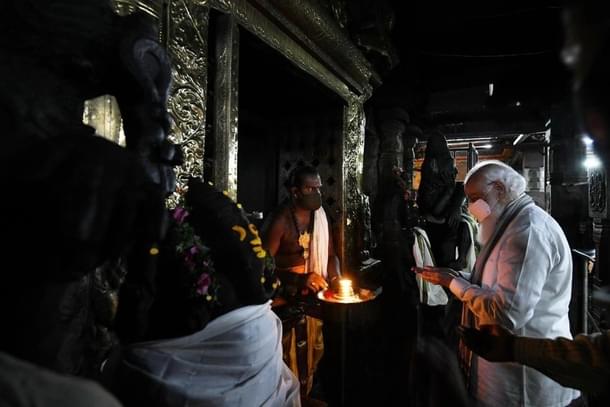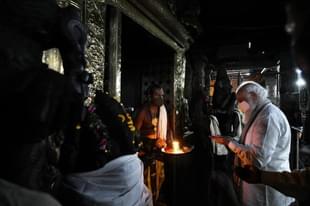Politics
'Oldest Language Of The World': Why PM Modi's View On Tamil Is Even More Important Than You Think
Aravindan Neelakandan
Jul 20, 2023, 02:16 AM | Updated 02:43 AM IST
Save & read from anywhere!
Bookmark stories for easy access on any device or the Swarajya app.


Some academic zealots and self-styled experts on 'Aryan Studies' are finding fault with Prime Minister Narendra Modi's oft-repeated claim that 'Tamil is older than Sanskrit'.
An objective assessment will suggest that PM Modi does not make these pro-Tamil statements for political gains. A seasoned politician like Modi will know that recognising a language's antiquity will hardly move the needle in electoral politics.
Right from the Ekta Yatra days of 1991, which started from Kanyakumari in Tamil Nadu, Modi has always expressed his reverence for Tamil - both language and people.
In 2009, when he was not even at the centre stage of national politics, Modi spoke passionately about the plight of Sri Lankan Tamils in an election rally in northern India.
After assuming office as PM of India in 2014, he has initiated a slew of measures to help the Sri Lankan Tamils.
Lately, a well-known Sri Lankan Tamil vlogger showcased the houses constructed by the Modi government for Sri Lankan Tamils and how the project indicated PM Modi's sincere goodwill towards the community in the war-torn country.
Modi's reverence towards Tamils contrasts with the 'silent complicity' of the self-proclaimed Dravidianist stock (primarily the Dravida Munnetra Kazhagam) in the Sri Lankan Tamil genocide 2009.
Tamil Older Than Sanskrit?
PM Modi's statement about Tamil being the oldest language is significant. While debate and discussions around it will continue, comparing it to the pseudo-scientific rhetoric of the Dravidianist groups—'first ape is Tamil ape'—is absurd.
Whether one accepts it or not, there is a possibility - a strong possibility- of linguistic elements flowing into the Harappan region from the West, which could make proto-Dravidian older than proto-Indo-European.
If one accepts the present linguistic framework, proto-Dravidian might be older than proto-Indo-European. All these theories, however, are in the nebulous realm of speculation.
What we do know is this: Sanskrit as we know it today and Tamil as we know it today emerged much later - after a long churn. Harappan culture itself was most probably multi-lingual.
It is this churn that is important. This churn constantly nurtures and rejuvenates Indian culture throughout the millennia.
So to a Hindutva-ite, it does not matter which language is older. What matters is this churning. In which diversity is accepted, harmonised and protected without monocultural domination.
However, a powerful section of academia, media and polity started ascribing an obsession with being the land's 'oldest' or 'purest' inhabitants as the basis of Hindutva.
Caricaturing Hindutva using Western racial right-wing models, they claimed that the Hindutva in India denied Aryan invasion theory because it proposed an indigenous Aryan race and posited Sanskrit as the mother of all languages.
With such a racial basis ascribed to Hindutva, it was be easy to project Hindutva as a racist or supremacist ideology.
On the other side, using the 'Aryan invasion model' to fuel local identity politics and propagating the questionable Aryan-non-Aryan binary made many questions the Aryan invasion theory.
Sure enough, archaeology does not substantiate an invasion or large-scale migration and genetic studies point to more of an interaction-integration scenario. Naturally, the critics of the 'Aryan invasion model' were enthusiastic. In that initial enthusiasm, some could have even gone overboard and could have claimed a the existence of a Sanskrit Harappan culture.
To be sure, even Dravidianist scholars like Iravatham Mahadevan and Asko Parpola have spoken about Vedic elements in Harappan culture. A dominant Vedic culture with a multi-linguistic society is undoubtedly the most viable scenario to imagine how India was five thousand years ago.
One must be cautious though. In the era of social media, it is easy to manipulate the Hindutvaites to argue for a purely Sanskrit-based Harappan civilisation.
Such a position is easy to demolish and helps discredit the entire Hindutva movement. This is despite the fact that Hindutva ideologues have consistently maintained that 'Aryan' is not a racial term at all.
PM Modi's statement—of Tamil's antiquity—may be a popularized version of the claim about proto-Dravidian in Harappan civilization, but the key point here is that Hindutva is open to various scenarios hinted at by archaeological and genetic discoveries.
This stance frees academic disciplines from political pressure and undermines the notion that Hindutva is predicated upon the notion of a Sanskrit-speaking, Aryan race indigenous to India.
PM Modi's statement will continue to be debated. Both academically and in the popular narrative. The important point here is that it has dealt a blow to those who sought to essentialise Hindutva as racial, ethnic movement.





